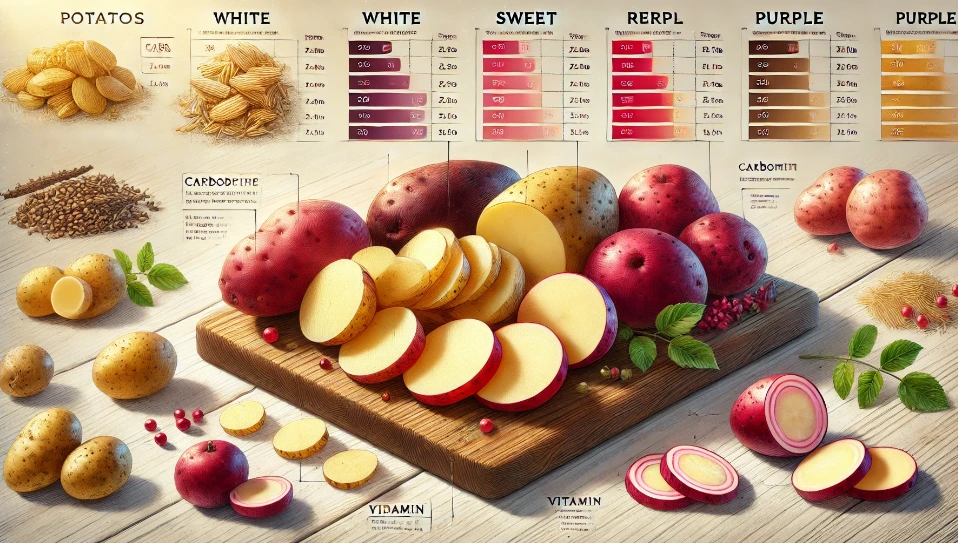Potatoes, one of the most widely consumed vegetables globally, are often debated when it comes to their health benefits, especially for those dealing with high blood pressure. Let’s take a closer look at how potatoes can impact blood pressure and explore their potential role in managing hypertension.
The Nutritional Profile of Potatoes
Potatoes are more than just a starchy side dish; they are packed with essential nutrients:
- Potassium: One of the most significant nutrients in potatoes is potassium, a vital mineral known for its ability to help manage blood pressure.
- Vitamin C: An antioxidant that helps protect cells from damage, vitamin C supports overall cardiovascular health.
- Fiber: Potatoes, particularly with the skin on, provide a good amount of dietary fiber, which can aid in digestion and improve heart health.
| Nutrient | Amount per 100g |
|---|---|
| Potassium | 425 mg |
| Vitamin C | 19.7 mg |
| Fiber | 2.2 g |
| Carbohydrates | 17 g |
| Protein | 2 g |
| Fat | 0.1 g |
How Potatoes May Help Lower Blood Pressure
Potatoes, especially when prepared healthily, can play a role in managing blood pressure. Here’s how:
1. Rich in Potassium
- Potassium is a critical nutrient for controlling blood pressure. It helps balance the negative effects of sodium by relaxing blood vessel walls, which reduces pressure. A potassium-rich diet is frequently recommended for those with hypertension.
2. Low in Sodium (When Unprocessed)
- Unprocessed potatoes are naturally low in sodium, a mineral that can raise blood pressure. It’s crucial to prepare potatoes without adding too much salt to retain this benefit.
3. Fiber Content
- The fiber in potatoes, especially when eaten with the skin, can help improve heart health by lowering cholesterol levels. High cholesterol is often associated with elevated blood pressure.
4. Antioxidants
- Potatoes contain antioxidants, like vitamin C, that reduce oxidative stress, which is associated with the development of hypertension.
Pros and Cons of Potatoes for Blood Pressure Management
While potatoes have many benefits, it’s essential to consider both their pros and cons, especially for those looking to lower blood pressure.
Pros:
- High Potassium Content: Helps in balancing sodium and reducing blood pressure.
- Versatile and Nutritious: Easy to include in a variety of heart-healthy dishes.
- Low Sodium: When prepared without added salt, they are naturally low in sodium.
- High in Fiber: When consumed with the skin, they can contribute to improved cardiovascular health.
Cons:
- Preparation Methods Matter: Fried or overly salted potatoes (such as fries or chips) can negate their health benefits and contribute to weight gain and high blood pressure.
- High Glycemic Index: Potatoes, especially when mashed or baked without the skin, have a high glycemic index, which can raise blood sugar levels—a concern for people with both hypertension and diabetes.
Recipes for Lowering Blood Pressure
Incorporating potatoes into a blood pressure-lowering diet is all about preparation. Here are some healthy potato recipes designed to help manage hypertension.
1. Roasted Potatoes with Garlic and Herbs
Ingredients:
- 4 medium potatoes (with skin)
- 2 tbsp olive oil
- 2 cloves garlic, minced
- Fresh rosemary and thyme
- Salt and pepper to taste (use sparingly)
Instructions:
- Preheat oven to 200°C (400°F).
- Cut the potatoes into wedges and place them in a bowl.
- Add olive oil, garlic, rosemary, and thyme. Toss to coat.
- Place the potato wedges on a baking sheet and roast for 30-35 minutes, turning halfway through, until golden brown.
- Season lightly with salt and pepper before serving.
Health Tip: The olive oil and garlic add heart-healthy fats and antioxidants, while using fresh herbs and minimal salt keeps the sodium content low.
2. Sweet Potato and Lentil Soup
Ingredients:
- 2 medium sweet potatoes, diced
- 1 cup red lentils
- 1 onion, chopped
- 2 cloves garlic, minced
- 1 tsp ground turmeric
- 1 tsp cumin
- 4 cups low-sodium vegetable broth
- Fresh cilantro for garnish
Instructions:
- In a large pot, sauté onions and garlic in a little olive oil until softened.
- Add turmeric and cumin, stirring for about a minute.
- Add diced sweet potatoes, lentils, and vegetable broth. Bring to a boil.
- Reduce heat, cover, and simmer for 20-25 minutes until the potatoes and lentils are tender.
- Blend the soup until smooth (optional) and garnish with fresh cilantro.
Health Tip: Sweet potatoes have a lower glycemic index than regular potatoes and are high in potassium, making them a great choice for managing blood pressure.
3. Baked Potato with Avocado and Greek Yogurt
Ingredients:
- 2 medium potatoes (with skin)
- 1 ripe avocado
- ½ cup plain Greek yogurt
- Juice of 1 lemon
- Fresh chives for garnish
- Salt and pepper to taste
Instructions:
- Preheat oven to 200°C (400°F).
- Pierce potatoes with a fork and bake for 45-50 minutes or until tender.
- In a bowl, mash the avocado with lemon juice, Greek yogurt, and season with salt and pepper.
- Once the potatoes are baked, slice them open and top with the avocado mixture. Garnish with fresh chives.
Health Tip: This dish combines the potassium benefits of potatoes and avocados with the probiotics of Greek yogurt, promoting heart and gut health.
Comparison Table: Potatoes vs. Other High Potassium Foods
| Food Item | Potassium per 100g |
|---|---|
| Potatoes | 425 mg |
| Sweet Potatoes | 337 mg |
| Bananas | 358 mg |
| Spinach | 558 mg |
| Avocados | 485 mg |
Tips for Including Potatoes in a Heart-Healthy Diet
To make potatoes a part of your blood pressure-lowering diet, follow these tips:
- Avoid Processed Potatoes: Stay away from processed forms like chips and fries, which are high in unhealthy fats and sodium.
- Cook with Heart-Healthy Oils: Use olive oil or avocado oil instead of butter or margarine.
- Eat the Skin: Potato skins are packed with fiber, which is essential for heart health.
- Pair with Vegetables: Combine potatoes with other vegetables like spinach, broccoli, or peppers to boost nutrient intake without increasing calorie content.
Other Lifestyle Changes for Managing Blood Pressure
While potatoes can play a role in a heart-healthy diet, they should be part of a broader lifestyle change to effectively manage blood pressure.
1. Reduce Sodium Intake
- The American Heart Association recommends consuming less than 2,300 mg of sodium per day, and ideally keeping it to 1,500 mg, especially for those with high blood pressure.
2. Increase Physical Activity
- Regular exercise strengthens the heart, helping it pump blood more efficiently, which can lower pressure on the arteries.
3. Maintain a Healthy Weight
- Excess weight can put strain on the heart and blood vessels, so maintaining a healthy weight is crucial for blood pressure management.
4. Limit Alcohol and Caffeine
- Both alcohol and caffeine can raise blood pressure in some individuals, so moderating consumption is essential.
Conclusion: Can Potatoes Help Lower Blood Pressure?
Potatoes can indeed be part of a healthy, blood pressure-lowering diet, but preparation is key. Their high potassium content makes them an excellent choice for managing blood pressure, as long as they’re not paired with excessive sodium or unhealthy fats. By choosing healthier preparation methods—like roasting, baking, or incorporating them into soups—and focusing on other heart-healthy ingredients, potatoes can contribute positively to overall cardiovascular health.
Incorporating these lifestyle changes along with the benefits of potatoes can be a step toward maintaining healthier blood pressure levels and supporting long-term heart health.



